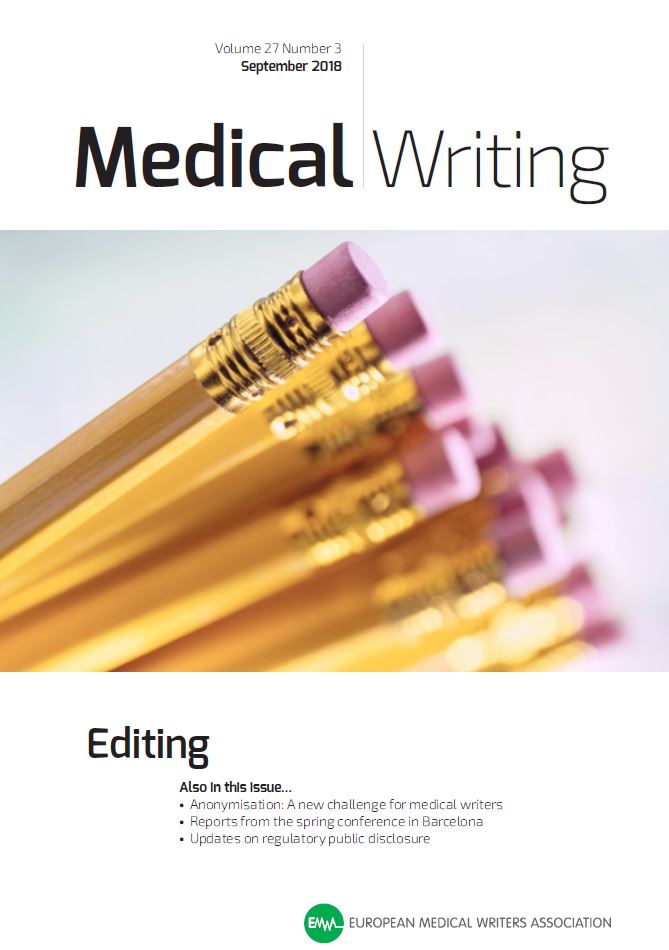
Volume 27, Issue 3 - Editing
Editing for writers who have English as an additional language
Author: Kari Skinningsrud
Abstract
Editors of English are typically met with expectations to make a quick fix of documents that need more radical changes than authors think. As editors, we should convey how we work to improve readability, and either adjustor gain acceptance for our approach. Next steps are to identify and discuss illogical, ambiguous content, check grammatical issues in the writer's first language that are different in English, and anything that deviates from clear,concise, consistent, well-formed prose, focused on the research question. A good way of communicating effectively with authors is to give reasons for suggested changes, and ideally,to name the problems.
 Download the full article
Download the full article
References
- Skinningsrud K. Teaching manuscript writ - ing in Africa. Med Writ. 2016;25(2):53–4.
- Cargill M, O’Connor P. Using the English articles (a/an/the) appropriately. In: Writing scientific research articles. Strategy and steps. Wiley-Blackwell; 2009:112–6.
- The University of Adelaide Writing Centre. Articles in English Grammar. 2014 [cited June 8] Available from: Available from: https:// www.adelaide.edu.au/writingcentre/sites/ default/files/docs/learningguidearticlesinenglishgrammar. pdf.
- Møller C. New medical writing courses in Copenhagen: Increasing chances of publication for non-native speakers. The Write Stuff. 2007:16(1):8–9.
- Annesley TM. The title says it all. Clin Chem. 2010;56(3):357–60.
- Akinshin A. English language and usage. 2018 [cited 2018 June 8]. Available from: Available from: https://english.stackexchange.com/ questions/188858/difference-betweenpurpose- aim-target-goal-objective-andambitio.
- Thabane L. Thomas T. Ye C, Paul J. Posing the research question: not so simple. Can J Aneshth. 2009;56:71–9.
- Driscoll DL. Purdue Online Writing Lab. Parallell structure. 2018 [cited 2018 June 8]. Available from: Available from: https://owl.english. purdue.edu/owl/resource/623/1/.
- Wells JM. Purdue Online Writing Lab. Modifiers. 2018 [cited 2018 June 9]. Available from: Available from: https://owl.english. purdue.edu/engagement/2/1/36/
- Arduengo M, Møller C, Every B, Lang T, Goodman N, Gudex C, Pedersen J, Guillemard M, Whereat A, Leventhal P. Writing better workbook. Med Writ. 2017;26(1):12–47.
- Freedman L, Plotnic J. University of Toronto. Writing Advice. Introductions and Conclusions. [cited 2018 June 10]. Available from: Available from: http://advice.writing. utoronto.ca/planning/intros-andconclusions/
- Faber J. Writing scientific manuscripts: most common mistakes. Dental Press J Orthod. 2017; 22(5):113–7.
- Resources for learning English. The-Ing forms. [cited 2018 June 10]. Available from: Available from: https://www.ef.com/englishresources/ english-grammar/ing-forms/
- Every B. Biomedical editor. Grammar tip: dangling modifier. [cited 2018 June 10]. Available from: Available from: http://www.biomedicaleditor.com/ grammar-tip-dangling.html
- English language and usage. 2012. [cited 2018 June 10]. Available from: Available from: https:// english.stackexchange.com/questions/ 84958/which-would-you-place-inparentheses- the-expansion-or-theabbreviation.
- GrammarBook.com. Hyphens. 2018. [cited 2018 June 10]. Available from: Available from: https://www.grammarbook.com/ punctuation/hyphens.asp.
Search
Articles
Links
Editoral Board
Editor-in-Chief
Co-Editors
Senior Editor
Victoria White
Managing Editor
Alicia Brooks Waltman
Associate Editors
Section Editors
AI/Automation
Biotechnology
Digital Communication
EMWA News
Freelancing
Gained in Translation
Getting Your Foot in the Door
Good Writing Practice
Pablo Izquierdo / Alison McIntosh
In the Bookstores
Publications
Medical Communications/Writing for Patients
Medical Devices
My First Medical Writing
News from the EMA
Pharmacovigilance
Regulatory Matters
Regulatory Public Disclosure
Louisa Ludwig-Begall / Sarah Kabani
The Crofter: Sustainable Communications
Veterinary Writing
Editors Emeritus
Layout Designer
Chris Monk
 Visit the EMWA website
Visit the EMWA website